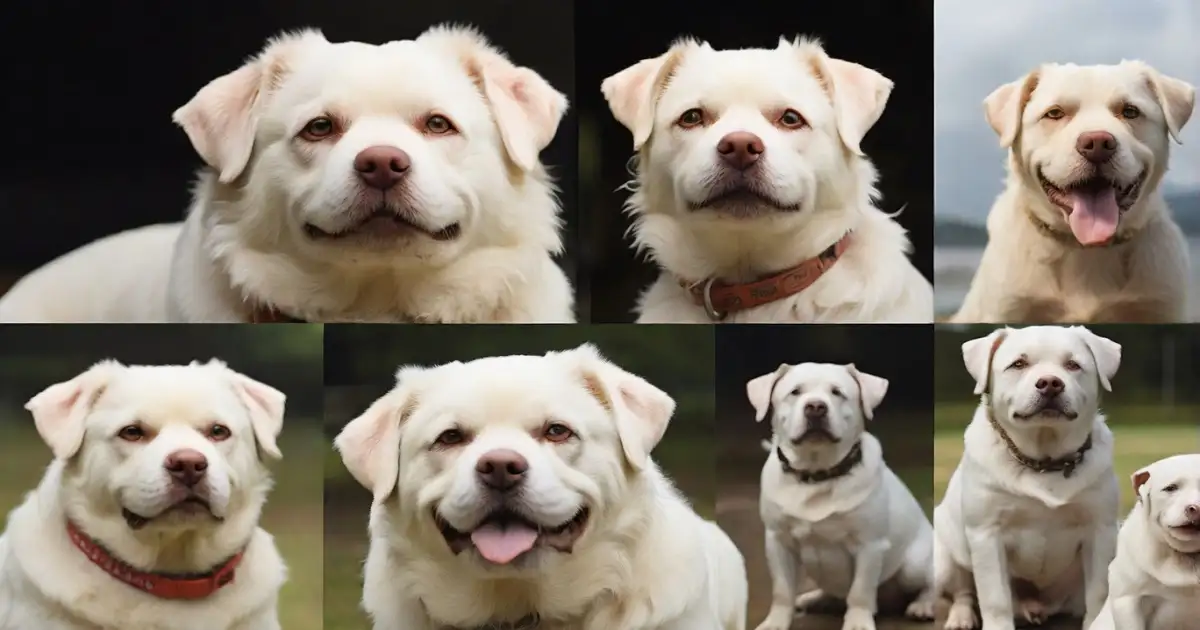The world of uncommon dog breeds holds an undeniable fascination for dog fanatics and professionals alike. Among the most fascinating is the albino white Rottweiler, a, without a doubt, precise genetic variation of this popular running breed.
With their snowy white coats and crimson eyes, these hanging puppies have captivated the interest of breeders and owners who want to recognize the genetics, proper care, and ethical concerns behind those uncommon animals.
For committed Rottweiler aficionados like Sarah, the hazard to learning about the realities of living with an albino white Rottweiler—from their origins and fitness to the practicalities of ownership—is a possibility to gain precious insights into a little-recognized nook of the Rottweiler global.
This article will delve into the genetics, care needs, breeding practices, and real-life stories related to those splendid albino white dogs.
Understanding the Genetics of Albino White Rottweilers
The key to understanding albino white Rottweilers lies in their specific genetics. While maximum Rottweilers sport the breed’s signature black coat with rich tan markings, albino white Rottweilers show off a recessive genetic mutation that suppresses all black pigment. This results in a brilliant white coat and light ruby or blue-colored eyes. But how does this rare albino phenotype originate?
Inheritance Patterns
Albinism in Rottweilers is connected to a latent allele transformation in the melanocortin 1 receptor (MC1R) quality, which controls the creation of the dark color eumelanin. For a Rottweiler to show the pale-skinned person aggregate, it should acquire two duplicates of this freak pale-skinned person (CC) allele, one from each parent. If both parents are albino white (CC), they will always produce albino white puppies.
- If one parent is albino white (CC) and the other is a carrier (Cw), there is a 50% chance of albino white puppies in each litter.
- Two carrier parents (CwCw) have a 25% chance of producing albino white puppies in a litter.
This is why albino white Rottweilers are so uncommon—they require inheriting the recessive albino gene from both sides of the pedigree. But they can still occur from time to time when two carrier dogs are bred.
Associated Health Risks
Unfortunately, the albino gene also carries some linked health concerns in Rottweilers. Lack of pigment leaves their skin and eyes more vulnerable to sun damage.
Albino white Rottweilers are also extra vulnerable to imaginative and prescient deficits and photophobia because of atypical eye development. Responsible breeders cautiously display their dogs for these issues using genetic testing.
While their seems can be putting, potential owners should be privy to the capacity fitness concerns associated with albino genetics. Careful breeding selection, health screening, and lifestyle adjustments can help minimize risks and ensure healthier, happier albino Rottweilers.
Value for Rottweiler Breeders
For reputable Rottweiler breeders, judiciously breeding albino white dogs can bring unique rewards. Producing these rare dogs provides buyers interested in the novelty of a white Rottweiler. More importantly, it lets in breeders to enhance their knowledge of dog genetics.
Meticulously tracking albino lineage helps breeders:
- Identify albino carriers in their lines
- Understand how albino genes are inherited
- Improve awareness of linked health issues
While albino white Rottweilers have captivated attention, there is still much to uncover about their origins, care, and propagation.
Caring for the Special Needs of Albino White Rottweilers
The unique genetics behind albino white Rottweilers also come with some special care requirements that owners should understand. While their basic needs are similar to any Rottweiler, accommodating their sensitivity to sunlight and potential vision issues takes extra consideration.
Protecting Their Skin and Eyes
Unlike black-pigmented Rottweilers, albino white dogs lack protective melanin in their skin and eyes. This makes them incredibly prone to sunburn and other UV damage when outdoors. Some important care steps include:
- Keep them out of direct sunlight – Avoid being outside during peak hours. Seek shaded areas on walks.
- Use doggie sunscreen – Apply over any exposed skin, like the nose, ears, and belly. Reapply frequently.
- Invest in UV-protection clothing – Special dog shirts, goggles, and scarves can provide barrier protection.
- Provide shade and shelter – Ensure they have shaded rest areas outdoors. Indoor stays are ideal.
With diligent sun-safety precautions, owners can let their albino white Rottweilers enjoy the outdoors safely. Monitoring skin for any sunburn or damage is also advised.
Supporting Eye Health
Albino white Rottweilers are prone to vision issues like photophobia, abnormal eye development, and even blindness. Catching problems early and providing support is key.
- Schedule veterinary eye exams – Have their eyes assessed annually for any defects.
- Use goggles outdoors – Tinted dog goggles filter harsh sunlight during daytime walks.
- Avoid visual stress – Limit exposure to bright lights indoors. Keep lighting gentle.
- Learn signs of vision issues – Contact the vet if you notice squinting, rubbing, or hesitance to go outdoors.
While not all albino white Rottweilers have serious vision impairments, taking steps to nurture eye health is advised. This allows them to minimize risk while living comfortably.
General Care and Enrichment
Beyond sun protection and eye health, albino white Rottweilers have the same general care needs as the breed standard:
- Exercise – Daily walks and playtime.
- Training and socialization – Important for all Rottweilers.
- Grooming – Occasional baths and weekly brushes.
- Proper diet – High-quality food for large breeds.
- Veterinary visits – Regular checkups and preventative care.
Making some adjustments to support their vision and skin needs, albino white Rottweilers can thrive as healthy, well-adjusted dogs. With dedicated care and enrichment from knowledgeable owners, their unique appearance doesn’t have to limit their quality of life.
The Ethical Responsibilities of Breeding Albino White Rottweilers
For breeders considering propagating albino white Rottweilers, important ethical obligations must be weighed. Albino dogs‘ striking appearance and rarity may be tempting, but producing them has consequences for the breed’s health and reputation. Responsible breeding practices are essential.
Prioritizing Health Screening
Thorough health screening is a must for ethical albino Rottweiler breeding. Albino dogs require extensive vet checks for:
- Skin cancer risks
- Eye defects and blindness
- Sunburn susceptibility
- Sensitivity to bright light
No dog showing serious health impairments should be bred. Extensive vet documentation of health clearances demonstrates a breeder’s integrity.
Honest Representation to Buyers
Breeders must transparently educate buyers on the realities of albino Rottweiler ownership. This includes:
- Explaining their special sun protection and eye care needs
- Preparing owners for potential vision issues
- Advising regular vet monitoring for skin cancer
- Providing health clearances for parent dogs
Minimizing risks starts with ensuring owners understand the care and considerations involved. Ethical representation is crucial.
Limiting Inbreeding
Recessive albino genes quickly concentrate through inbreeding. Responsible breeders avoid overusing related albino sires and dams. Instead, they thoughtfully widen bloodlines and partner albino dogs with unrelated black Rottweilers.
While tempting to produce more people with albinism, heavy inbreeding risks inherited conditions. Occasional judicious outcrossing is vital for health.
Saying “No” for the Right Reasons
Just because a rare albino puppy can be produced does not mean it should be. Declining buyers seeking albino dogs as fleeting novelties, not lifetime companions, is advised.
Ethical breeding practices sometimes mean turning down dollars in favor of doing what’s best for Rottweiler’s welfare.
Making Contributions to the Breed
Reputable albino Rottweiler breeding should advance the breed through participation in showing, clubs, databases, and research. Dedicated breeders have much to contribute.
By embracing ethics over economics, albino white Rottweiler breeders demonstrate their commitment to the dogs above all else.
Insights From Albino White Rottweiler Owners and Breeders
To provide an inside look at life with these unique dogs, perspectives from real owners and breeders of albino white Rottweilers can prove invaluable. Their first-hand experiences reveal the joys and challenges of caring for albino Rottweilers.
Enriching Companions Despite Challenges
Long-time Rottweiler breeder Martha Stewart recalls the pleasant surprise of her first albino litter. Though initially cautious, she found the albino puppies to have wonderful temperaments with their breed’s classic loyalty and goofiness—albeit with extra sun sensitivity.
While diligent about their sun protection and eye health, Stewart says her albino champions live full, enriched lives as her constant companions, showing it is possible to accommodate their special needs successfully.
Difficulty Finding Homes That Understand Care Needs
Jonathan Smith, another established breeder, has occasionally produced albino Rottweilers over the years. He emphasizes the difficulty of finding informed owners able to manage their photosensitivity and potential vision issues properly.
Smith refuses to sell his rare albinos to purely novelty-seeking owners, wanting to ensure their special needs are met in an appropriate home. He hopes more education will improve albino adoption outcomes.
Rewarding but Challenging
Chris Davis*, a first-time Rottweiler buyer, decided to adopt an albino puppy from a local breeder. While smitten with his pup Callie’s white coat, Davis admits being unprepared for the reality of her extensive sun precautions and discovering her impaired eyesight.
Though rewarding in raising Callie, Davis says her needs have been more challenging than expected. He encourages other prospective albino owners to extensively research proper care before committing.
Vet Perspectives on Health Considerations
Local veterinarian Dr. Jennifer Kim sees albino Rottweilers infrequently in her practice. She emphasizes to owners the heightened skin cancer risks, potential for sunburn, and importance of proactive ophthalmological care for these dogs.
With dedicated prevention and monitoring, Dr. Kim believes albino Rottweilers can live full lives. But she always ensures owners understand the health considerations involved before taking these dogs home.
Through first-hand accounts from those directly involved with albino white Rottweilers, important insights and perspectives can guide others interested in the breed. Their collective experiences highlight the unique joys as well as realities of living with these striking but special needs dogs.
Conclusion: Key Considerations for Albino White Rottweilers
For Rottweiler enthusiasts intrigued by the idea of welcoming one of these rare albino white dogs into their life, this deep dive highlights several key considerations to weigh:
Understand Their Unique Genetics
Albino traits stem from a recessive genetic mutation affecting pigment. Albino Rottweilers require inheriting two copies of this gene to exhibit their white coats. This is why they are uncommon. Their genetics also predispose them to certain health risks.
Recognize Their Special Care Needs
Lacking protective pigment, albino white Rottweilers demand vigilant sun protection and proactive eye care. Their photosensitive skin and eyes require adjustments to support their well-being. Not all owners may be equipped for this commitment.
Research Reputable Breeders
Seeking out responsible, ethical breeders committed to health screening and transparency is advised. Their breeding practices directly impact albino Rottweiler welfare. Supporting knowledgeable breeders advances the breed.
Prepare For Potential Challenges
While rewarding companions, albino white Rottweilers can present challenges. Vision impairments, sun precautions, and sensitivity to light warrant consideration. Realistic expectations are important.
Embrace Their Rarity Responsibly
Albino Rottweilers offers the chance to care for a truly unique dog. But their novelty should not outweigh a dedication to the breed’s health and temperament. Ethical motivations are paramount.
For Sarah and other prospective owners captivated by their distinctive appearance, albino white Rottweilers can be deeply enriching companions. With responsible ownership, right care, and realistic expectations, the fun and challenges of those special dogs may be richly profitable.
Frequently Asked Questions
Why does my Rottweiler have blue eyes?
- Blue eyes in Rottweilers are caused by a rare genetic mutation that results in a lack of pigmentation. This is called an albino gene. For a Rottweiler to have blue eyes, it must inherit two copies of this recessive albino gene, one from each parent.
What is the rarest color of Rottweiler?
- The rarest and most unique color variation in Rottweilers is albino white. These dogs have a pure white coat, light-colored nose, and pale blue or ruby eyes due to their albino genetics. They lack the black pigment seen in standard Rottweiler coloring.
Is there such a thing as an albino Rottweiler?
- Yes, albino Rottweilers do exist, but they are exceptionally rare. They exhibit the distinctive white coat, light eyes, and pigment loss associated with albinism as a result of inheriting two copies of a recessive mutant gene.
How rare is it for a dog to have blue eyes?
- Blue or odd-colored eyes are uncommon in dogs. Most breeds have brown eyes as the predominant gene. Exceptions like Siberian Huskies show blue eyes more frequently, but in other breeds like Rottweilers, blue eyes are quite rare and indicate the albino mutation.
Do purebred dogs have blue eyes?
- While uncommon, some purebred dog breeds can have blue eyes, often linked to piebald genes or albinism – examples include Siberian Huskies, Border Collies, Dachshunds, Dalmatians, and Australian Shepherds. So, blue eyes can occur in purebreds, but it’s due to rare genetic factors.









